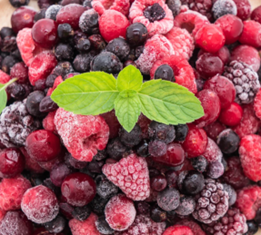Ultra-Processed Foods (UPF): What They Are, Why They Matter, and How to Live With Them
Jun 12 / CATEGORY: Nutrition
Estimated reading time: 3 minutes, 45 seconds
College life can be busy, sometimes chaotic, and frequently on the go. Snacks, convenience, and  prepared foods often make the difference between fueled and focused versus hangry and distracted. Some of our favorite snacks and foods have recently been caught in a whirlwind of news: Ultra-processed foods (“UPF”)! The headlines shout that they are ALL “bad” for you and your health. But wait, what does ultra-processed really mean? Are we doomed to a lifetime of dodging Doritos? Let’s unwrap it all in a way that makes sense for college — because balance, not obsession, is key.
prepared foods often make the difference between fueled and focused versus hangry and distracted. Some of our favorite snacks and foods have recently been caught in a whirlwind of news: Ultra-processed foods (“UPF”)! The headlines shout that they are ALL “bad” for you and your health. But wait, what does ultra-processed really mean? Are we doomed to a lifetime of dodging Doritos? Let’s unwrap it all in a way that makes sense for college — because balance, not obsession, is key.
Before we talk about ultra-processed foods, let’s break down what processing means. Processing happens whenever food is altered from its natural state. This can range from minimal changes, like chopping or freezing vegetables, to more complex ones involving multiple steps and ingredients.
Here’s a quick breakdown:
- Minimally processed foods: Washing, freezing, or drying to preserve freshness (e.g.,
 frozen peas, pre-washed spinach).
frozen peas, pre-washed spinach). - Processed foods: Foods with added salt, sugar, or oil for flavor or preservation (e.g., canned beans, whole-grain bread).
- Ultra-processed foods (UPFs): Foods that undergo multiple steps of industrial processing and contain ingredients extracted from foods—like starches, sugars, or fats—alongside additives such as artificial colors, flavors, or stabilizers.
Interestingly, there isn’t a single, universally accepted definition of UPFs. However, a common working definition is that ultra-processed foods are made mostly from substances extracted from foods, like fats, starches, added sugars, and hydrogenated fats. They may also contain synthetic additives like artificial colors, flavors, or stabilizers that enhance shelf life, texture, or taste.
Examples of UPFs include:
- Soda and sugary drinks
- Packaged snack foods (chips, candy, cookies)
- Instant noodles
- Sweetened breakfast cereals
- Store-bought pastries or muffins
- Shocking one: Many seemingly healthy items like flavored yogurt, protein bars, or whole-grain bread often fall into the UPF category due to added ingredients.
Consistently relying on UPFs for a significant portion of your diet can have real consequences for your health. Research backs this up.
For instance, a study published in The BMJ (1) tracked the dietary habits of over 100,000 adults for five years. The findings? People who consumed more UPFs had a higher risk of cardiovascular disease, coronary heart disease, and cerebrovascular disease—even when researchers accounted for the nutritional quality of their diets. While this observational study doesn’t prove cause and effect, it highlights a significant association between ultra-processed diets and heart health.
Other research has linked high UPF consumption to:
- Lower Nutritional Quality: UPFs tend to be nutrient poor and low in fiber, leaving you hungry again sooner.
- Energy crashes: The combination of added sugars and refined carbs can lead to blood sugar spikes followed by sluggish energy levels.
In general, research has suggested that the potential health detriments of UPF consumption have more to do with the ultra-processing practice overall and less to do with specific ingredients such as additives, colorants/dyes, or stabilizers. (2)
While the research is concerning, let’s be real—avoiding UPFs entirely is almost impossible, and unnecessary, for most individuals. Between tight schedules and tighter budgets, pre-packaged and convenient foods are often a go-to. Here’s why a “100% unprocessed” diet can be challenging:

- Financial Costs: Fresh, whole foods can be expensive. Relying solely on these options may not be feasible on a college budget.
- Time Constraints: Planning, preparing, cooking, and eating fresh meals from scratch requires time —something we don’t always have between classes, jobs, and extracurriculars.
- Almost All Foods Are Processed: Unless you’re plucking apples straight from the tree, most foods undergo some degree of processing. That whole-grain pasta? Processed. Your almond butter? Processed. Processing itself isn’t inherently bad—it’s about the level of processing and how much UPFs complete your overall dietary intake.
Demonizing UPFs won’t help your health, and trying to eat 100% unprocessed is often unrealistic — especially for busy, financially-constrained college students. Instead, focus on  balance: enjoy your favorite snacks occasionally, and aim to make most of your meals nutrient-dense and satisfying.
balance: enjoy your favorite snacks occasionally, and aim to make most of your meals nutrient-dense and satisfying.
Life is about more than rigid food rules. It’s about fueling your body in ways that make sense for your time, budget, and lifestyle. And yes, that sometimes means instant ramen at midnight—no shame.
This post was co-written by:
Jessie is a Registered Dietitian and Assistant Director for Fitness & Wellness at the University of Florida’s Department of Recreational Sports, where she does individual nutrition counseling and coaching with the UF community. Follow her on Instagram for more nutrition tidbits.
Nirali is a Program Assistant with Nutrition Services at the Department of Recreational Sports. She is a 4th-year Dietetics major with a minor in Health Promotion.
(1) Srour B, Fezeu L K, Kesse-Guyot E, Allès B, Méjean C, Andrianasolo R M et al. Ultra-processed food intake and risk of cardiovascular disease: prospective cohort study (NutriNet-Santé) BMJ 2019; 365 :l1451 doi:10.1136/bmj.l1451
(2) Visioli, F., Del Rio, D., Fogliano, V. et al.Ultra-processed foods and health: are we correctly interpreting the available evidence?. Eur J Clin Nutr 79, 177–180 (2025). https://doi.org/10.1038/s41430-024-01515-8
